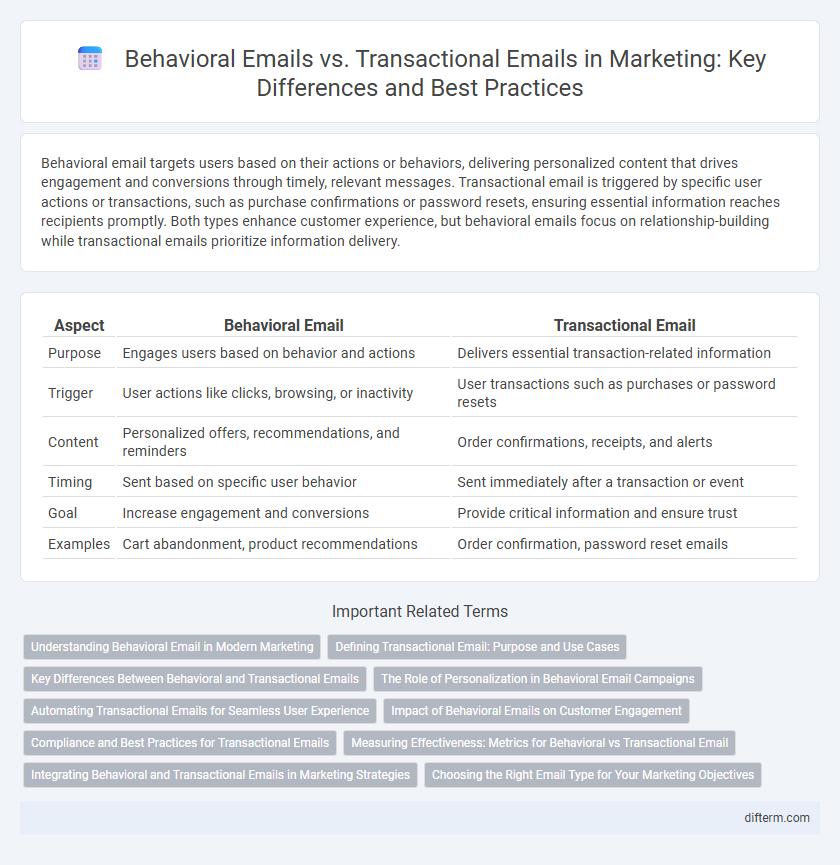Behavioral email targets users based on their actions or behaviors, delivering personalized content that drives engagement and conversions through timely, relevant messages. Transactional email is triggered by specific user actions or transactions, such as purchase confirmations or password resets, ensuring essential information reaches recipients promptly. Both types enhance customer experience, but behavioral emails focus on relationship-building while transactional emails prioritize information delivery.
Table of Comparison
| Aspect | Behavioral Email | Transactional Email |
|---|---|---|
| Purpose | Engages users based on behavior and actions | Delivers essential transaction-related information |
| Trigger | User actions like clicks, browsing, or inactivity | User transactions such as purchases or password resets |
| Content | Personalized offers, recommendations, and reminders | Order confirmations, receipts, and alerts |
| Timing | Sent based on specific user behavior | Sent immediately after a transaction or event |
| Goal | Increase engagement and conversions | Provide critical information and ensure trust |
| Examples | Cart abandonment, product recommendations | Order confirmation, password reset emails |
Understanding Behavioral Email in Modern Marketing
Behavioral email leverages user actions and preferences to deliver personalized content, increasing engagement rates and customer retention in modern marketing. By analyzing interactions such as website visits, purchase history, or email clicks, marketers craft targeted messages that resonate on an individual level. This data-driven approach outperforms generic campaigns by fostering stronger customer relationships and driving higher conversion rates.
Defining Transactional Email: Purpose and Use Cases
Transactional emails serve specific functions triggered by user actions, such as order confirmations, password resets, and shipping notifications. These emails provide essential information to facilitate or complete a transaction, enhancing customer experience and trust. Their primary purpose is to deliver timely, relevant content that supports user engagement without promotional intent.
Key Differences Between Behavioral and Transactional Emails
Behavioral emails are triggered by specific user actions or behaviors, targeting engagement and nurturing through personalized content, while transactional emails are automated messages confirming or facilitating a transaction, such as order confirmations and password resets. Behavioral emails rely on customer interaction data to drive retention and conversion, whereas transactional emails prioritize timely delivery and accuracy to maintain service functionality and trust. Understanding these distinctions helps marketers optimize email strategies for improved customer experience and ROI.
The Role of Personalization in Behavioral Email Campaigns
Behavioral email campaigns leverage personalized data such as browsing history, purchase patterns, and user preferences to deliver highly relevant content that drives engagement and conversion rates. Unlike transactional emails, which are triggered by specific actions like order confirmations or password resets, behavioral emails utilize dynamic segmentation and tailored messaging to nurture customer relationships and increase lifetime value. Personalization in these campaigns enhances user experience by providing timely, targeted communications that align with individual behaviors and interests.
Automating Transactional Emails for Seamless User Experience
Automating transactional emails enhances user experience by delivering timely, relevant messages such as order confirmations, password resets, and shipping notifications without manual intervention. Integrating behavioral data with transactional email systems allows marketers to customize content based on user actions, increasing engagement and satisfaction. Leveraging automation in transactional emails reduces response times and supports scalable communication across customer journeys.
Impact of Behavioral Emails on Customer Engagement
Behavioral emails, triggered by user actions such as abandoned carts or browsing history, significantly boost customer engagement by delivering highly personalized and relevant content. These emails achieve up to 70% higher open rates and 80% more click-through rates compared to traditional batch sends, driving increased conversions and brand loyalty. By aligning messages with individual behaviors, marketers foster stronger emotional connections and timely interactions that transactional emails targeting specific purchase confirmations or account activities cannot replicate.
Compliance and Best Practices for Transactional Emails
Transactional emails must comply with regulations such as CAN-SPAM and GDPR by including accurate sender information and avoiding promotional content to maintain their transactional nature. Best practices for transactional emails emphasize timely delivery, clear messaging, and minimal design to enhance user experience and trust. Ensuring opt-in consent and providing easy access to privacy policies further support compliance and customer confidence.
Measuring Effectiveness: Metrics for Behavioral vs Transactional Email
Behavioral emails drive engagement through metrics like open rates, click-through rates, and conversion rates linked to user actions, providing insights into customer preferences and lifecycle stages. Transactional emails focus on deliverability, open rates, and immediate action metrics such as purchase confirmation or password reset completions to ensure critical communications are received and acted upon. Comparing these metrics helps marketers optimize campaigns by balancing personalized content with essential transactional interactions.
Integrating Behavioral and Transactional Emails in Marketing Strategies
Integrating behavioral and transactional emails in marketing strategies enhances customer engagement by delivering personalized content based on user actions and real-time transactions. Behavioral emails leverage data such as browsing history and purchase behavior to trigger targeted messages that nurture leads, while transactional emails provide essential information like order confirmations and shipping updates. Combining these email types creates a cohesive customer journey that boosts retention, increases conversion rates, and maximizes revenue opportunities.
Choosing the Right Email Type for Your Marketing Objectives
Behavioral emails trigger personalized content based on user actions, increasing engagement and driving conversions by addressing specific customer journeys, while transactional emails deliver essential information related to purchases or account activities, ensuring critical communication is timely and reliable. Selecting the right email type depends on marketing objectives: use behavioral emails to nurture leads and boost retention, and transactional emails to build trust and provide necessary service updates. Aligning email strategy with goals improves open rates, click-throughs, and overall campaign ROI.
Behavioral Email vs Transactional Email Infographic

 difterm.com
difterm.com